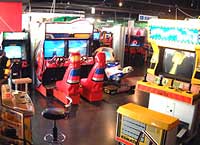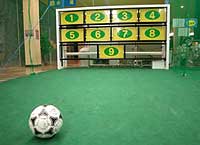|
|
|||||||
|
|
|||||||
|
|||||||
| | Web Japan >>| Trends in Japan >> | Arts & Entertainment >> | Cheap Thrills | |
|
CHEAP THRILLS ¥100 Recreation a Big Hit (November 18, 2003) Popular in Japan over the past decade or so, ¥100 shops offer a variety of goods for the same low price. In the same mold, a number of leisure facilities that charge for their services in units of ¥100 ($0.91 at ¥110 to the dollar) have recently emerged. The trend for ¥100 leisure is taking off in amusement facilities and sports clubs all over Japan. Although many of these establishments require a separate registration fee, paying in easy-to-understand ¥100 units is proving popular with the public.
Paying in Multiples of ¥100 Proves Popular In the town of Oyama, Shizuoka Prefecture, the Gatsby Golf Club has a novel way of calculating green fees: Each stroke costs ¥100. While a basic fee of ¥4,000 ($36.36) is required (this includes lunch), the rest of the cost is dependent on the player's skill. For example, someone who shoots a 71 over 18 holes would pay ¥7,100 ($64.55) in addition to the basic fee, or a total of ¥11,100 ($100). The upper limit on strokes is 100 for women and 110 for men; any strokes above this number are free. On the weekends, the course is crowded with golfers trying hard to keep their scores - and their green fees - down.
In addition to the various ¥100 recreational activities it offers, Fujiyama Land is considering adding a fishing pond that will allow visitors to catch such saltwater fish as mackerel, yellowtail, and blowfish. In the plan under consideration, fishing rods would be rented for about ¥400 ($3.64), and customers would be free to take home any fish they catch. The park's future plans include adding dining facilities that would allow people to eat the fish they caught right on the premises. While such a facility would likely have high overheads and low profitability, the aim of the company is to provide new opportunities for people to enjoy fishing in an urban environment.
Shorter Time Increments Equal Greater Satisfaction? Many people view being able to pay for their leisure activities in 15-minute increments as a bargain. Charging by the hour is the standard practice at most recreational facilities, and the advantage of shorter time increments is that people can enjoy themselves without watching the clock. Another benefit is that people can soon quit an activity that they are not enjoying without having to pay more than ¥100. The appeal of being able to pay in small increments for exactly the time spent having fun looks set to make ¥100 activities a common feature of Japan's leisure market. Related Web Sites¥100 Shops in Nipponia JJ Club 100 (Japanese only) Joyfit Gatsby Golf Club (Japanese only) Fujiyama Land (Japanese only) Copyright (c) 2004 Web Japan. Edited by Japan Echo Inc. based on domestic Japanese news sources. Articles presented here are offered for reference purposes and do not necessarily represent the policy or views of the Japanese Government. |
WHO NEEDS TOKYO? (November 9, 2000) |
|||||||
|
||||||||




